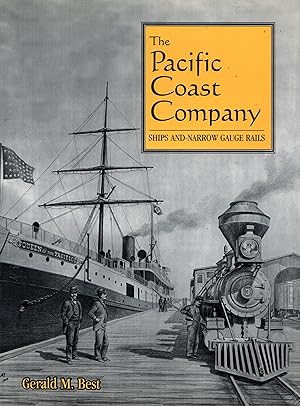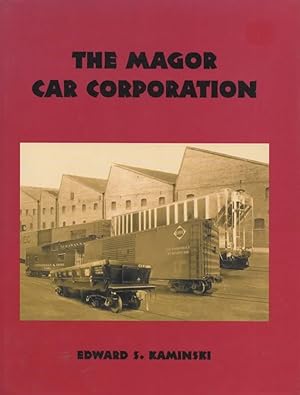signature press california usa (3 Ergebnisse)
Produktart
- Alle Produktarten
- Bücher (3)
- Magazine & Zeitschriften
- Comics
- Noten
- Kunst, Grafik & Poster
- Fotografien
- Karten
-
Manuskripte &
Papierantiquitäten
Zustand
Einband
- alle Einbände
- Hardcover
- Softcover
Weitere Eigenschaften
- Erstausgabe (2)
- Signiert
- Schutzumschlag
- Angebotsfoto
- Kein Print-on-Demand
Land des Verkäufers
Verkäuferbewertung
-
The Pacific Coast Company: Ships and Narrow Gauge Rails
Verlag: Signature Press, Wilton, California, USA, 1997
ISBN 10: 0963379119ISBN 13: 9780963379115
Anbieter: Train World Pty Ltd, North Brighton, VIC, Australien
Buch
Hardcover. Zustand: As New. Zustand des Schutzumschlags: Very Good. Reprint. 154 Pages with Black/White Photos, Illustrations and Maps. The Pacific Coast Company was a fascinating rail-marine operation which served the West Coast from San Diego to Alaska. Its rail components were both narrow gauge and, later, standard gauge railroads, and from its inception in the late eighteenth century, it was an important factor in the growth of California and the West. The earliest part of the system began as a horse-drawn rail line near San Luis Obispo, from which a full-fledged narrow-gauge railroad developed. Complementing the railroad was a fleet of the coastwise steamers which dominated California's north-south transportation in the 19th century. Another horse-drawn railroad was in San Diego, and a third rail operation was at Seattle, consolidating a group of small railroads. Later it became a gateway to the city for Northern Pacific, the Milwaukee Road, and Union Pacific, as well as connecting with the company's steamships. The Seattle line, last survivor of the Pacific Coast Co., was finally absorbed into the Great Northern Railway in 1965. This flourishing and extensive transportation empire reached its zenith in 1915, with rail feeders for a fleet of 78 steamships ranging along the California coast and serving Alaska as well. The book contains numerous historic and rare photographs, as well as roster information on the equipment of both rail and ship operations. Out of print since 1983, the first edition of this book has become difficult to find from used book dealers, so its return to print is welcome. Careful printing and use of the original page negatives has permitted an edition of quality equal to or better than the original. The story is well written and extensively researched. It's a readable and informative tour through some intriguing Western history. Not Signed.
-
The Magor Car Corporation
Verlag: Signature Press, California, USA, 2000
ISBN 10: 1930013043ISBN 13: 9781930013049
Anbieter: Train World Pty Ltd, North Brighton, VIC, Australien
Buch Erstausgabe
Hardcover. Zustand: As New. Zustand des Schutzumschlags: Very Good. 1st Edition. 200 pages b/w photos - The Magor Car Corporation, located in northern New Jersey at Clifton, was a significant railcar builder throughout much of the twentieth century. It had its origins in a partnership founded in 1899 by Basil Magor and Robert Wonham, which led in 1902 to a manufacturing operation called the Wonham-Magor Engineering Works. In the first part of the century, Magor concentrated on export railcars, aided by its proximity to the port of New York. Basil's brother, Robert Magor, also became associated with the company, and in 1910 it became the Magor Car Company. It was incorporated in 1917 as the Magor Car Corporation : among its major stockholders was J.P. Morgan. In 1914, Magor's first freight cars for revenue use on an American railroad were built, and such sales grew steadily thereafter, though export cars continued as the company's mainstay for some years. In 1918, Magor was among the many firms which built cars for the United States Railroad Administration as part of its effort to construct 100,000 standard freight cars. During World Wars I and II as well as during the Korean conflict, Magor was called on for thousands of export cars for military needs, and was also a principal builder of cars for Europe under the Marshall Plan. In 1959, Magor built its first aluminum-bodied covered hopper cars, which were also the first to be placed in U.S. revenue service, and went on to build more than 5000 aluminum cars. Magor's sale in 1964 to Fruehauf Corporation marked many changes in its activities, among which was the dissolution of the joint sales operation with National Steel Car Corp. of Canada, an arrangement in effect since Basil Magor founded that firm in 1911. Declining railcar sales during the 1960s led to Magor's closure in 1973. Magor was an important builder of American freight cars, though not one of the larger builders. Its history is a significant part of United States railroad history.
-
The Magor Car Corporation
Verlag: Signature Press, California, USA, 2000
ISBN 10: 1930013043ISBN 13: 9781930013049
Anbieter: Train World Pty Ltd, North Brighton, VIC, Australien
Buch Erstausgabe
Hardcover. Zustand: New. Zustand des Schutzumschlags: New. 1st Edition. 200 Pages with Black/White Photo. The Magor Car Corporation, located in northern New Jersey at Clifton, was a significant railcar builder throughout much of the twentieth century. It had its origins in a partnership founded in 1899 by Basil Magor and Robert Wonham, which led in 1902 to a manufacturing operation called the Wonham-Magor Engineering Works. In the first part of the century, Magor concentrated on export railcars, aided by its proximity to the port of New York. Basil's brother, Robert Magor, also became associated with the company, and in 1910 it became the Magor Car Company. It was incorporated in 1917 as the Magor Car Corporation : among its major stockholders was J.P. Morgan. In 1914, Magor's first freight cars for revenue use on an American railroad were built, and such sales grew steadily thereafter, though export cars continued as the company's mainstay for some years. In 1918, Magor was among the many firms which built cars for the United States Railroad Administration as part of its effort to construct 100,000 standard freight cars. During World Wars I and II as well as during the Korean conflict, Magor was called on for thousands of export cars for military needs, and was also a principal builder of cars for Europe under the Marshall Plan. In 1959, Magor built its first aluminum-bodied covered hopper cars, which were also the first to be placed in U.S. revenue service, and went on to build more than 5000 aluminum cars. Magor's sale in 1964 to Fruehauf Corporation marked many changes in its activities, among which was the dissolution of the joint sales operation with National Steel Car Corp. of Canada, an arrangement in effect since Basil Magor founded that firm in 1911. Declining railcar sales during the 1960s led to Magor's closure in 1973. Magor was an important builder of American freight cars, though not one of the larger builders. Its history is a significant part of United States railroad history. Not Signed.




